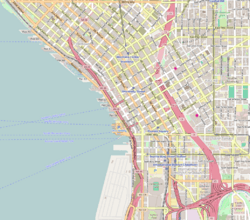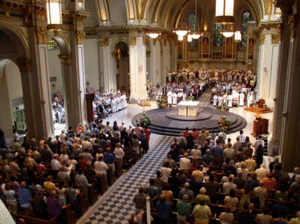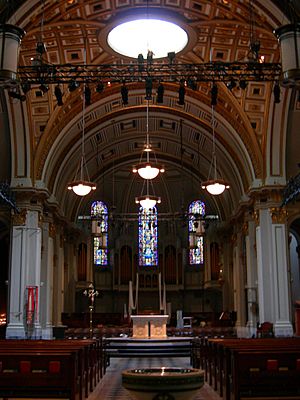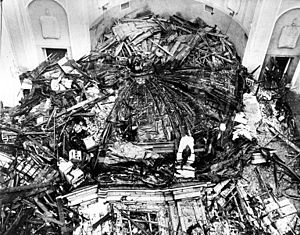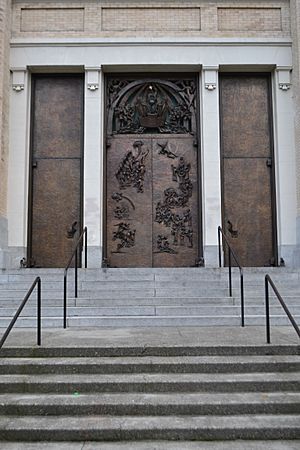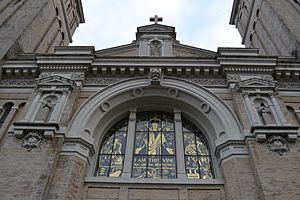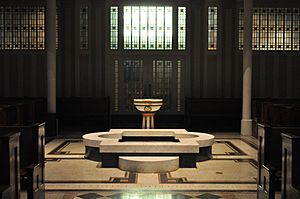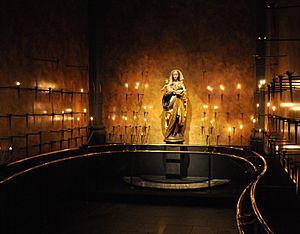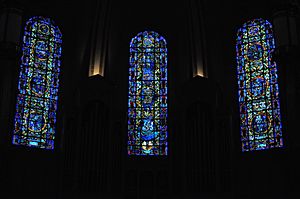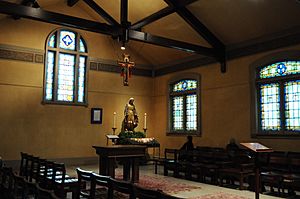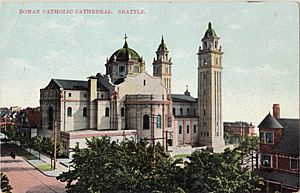St. James Cathedral (Seattle) facts for kids
Quick facts for kids St. James Cathedral |
|
|---|---|
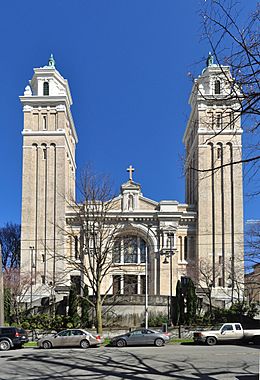
Panoramic view of the western façade
|
|
| 47°36′28″N 122°19′33″W / 47.6077°N 122.3258°W | |
| Location | 804 Ninth Avenue Seattle, Washington |
| Country | United States |
| Denomination | Catholic Church |
| History | |
| Status | Cathedral |
| Architecture | |
| Functional status | Active |
| Heritage designation | Seattle Landmark |
| Designated | March 12, 1984 |
| Architect(s) | Heins & LaFarge |
| Style | Renaissance Revival |
| Completed | 1907 |
| Specifications | |
| Dome height (outer) | 120 feet (37 m) – collapsed in 1916; never rebuilt |
| Number of spires | Two |
| Spire height | 167 feet (51 m) |
| Administration | |
| Archdiocese | Seattle |
St. James Cathedral is a beautiful Catholic church in Seattle, Washington. It is the main church for the Archdiocese of Seattle and where the archbishop leads. The cathedral is named after St. James the Greater, who is a special saint for the archdiocese.
The idea for a big church in Seattle started in 1903. At that time, Bishop Edward O'Dea decided to move the main church office from Vancouver, Washington, to Seattle. Building the cathedral began in 1905, and it was officially opened in 1907. In 1916, a large dome on the church fell down, leading to big repairs. More updates happened in 1950 and 1994. In 1984, the cathedral and its surrounding buildings became important city landmarks.
Contents
History of St. James Cathedral
The church area, called the Diocese of Nesqually, was created in 1850. Its first bishop, Augustin-Magloire Blanchet, opened a cathedral in Vancouver, Washington, in 1851.
Later, another bishop, Aegidius Junger, built a new St. James Cathedral in Vancouver in 1885. This church was used for 18 years and is still a Catholic church today.
Bishop Edward O'Dea, who came after Junger, saw that Seattle was growing fast. So, in 1903, he moved the main church office to Seattle. He immediately started planning a new cathedral.
Building the Cathedral
Bishop O'Dea bought the land for the cathedral in 1903. Planning started in 1904, and construction began in early 1905. Over 5,000 people came to see the cornerstone laid on November 12, 1905. This was the biggest religious gathering in Seattle at that time.
While the cathedral was being built, a small temporary church, St. Edward's Chapel, was used. The church area was officially renamed the Diocese of Seattle on September 11, 1907. The new St. James Cathedral opened on December 22, 1907.
Dome Collapse and Renovations
On February 2, 1916, the large 60-foot dome on top of the cathedral collapsed. It fell because of heavy snow. The dome was never rebuilt. When the cathedral reopened in March 1917, the inside looked very different.
Another big renovation happened in 1950 to celebrate 100 years of the diocese. In 1984, the Seattle City Council named the cathedral, its rectory (priest's house), and the grounds as important city landmarks.
The most recent major renovation was in 1994. During this time, the main altar was moved to the center of the building. A new round window and skylight were added where the dome used to be. Also, special items (relics) of St. Frances Xavier Cabrini were placed under the altar. She had prayed at the cathedral when she worked in Seattle.
Today, the cathedral helps many people in need. It has programs for the poor, homeless, and immigrants. These programs include a kitchen, homeless ministry, and assistance for immigrants.
Outside the Cathedral
St. James Cathedral has amazing artwork on its exterior.
Stained Glass and Bronze Doors
The cathedral has many beautiful stained glass windows made by Charles Connick between 1917 and 1920. In 1994, three new windows were added. These were created by Hans Gottfried von Stockhausen, a famous German artist.
In 1999, special bronze doors were added. They were made by German sculptor Ulrich Henn. The central doors show people's journey to a heavenly city. Scenes from the Old Testament, like the expulsion from Eden and Moses leading his people, are on the left. Scenes from Jesus' life, like his baptism and carrying the cross, are on the right.
Above the door, a sculpture shows the Lamb of God leading everyone to the heavenly city. Rivers flow from the city, and trees grow with fruit for healing. This image shows a new, better paradise.
Windows and Statues
Above the west door, there is a black and gold window from 1950. It shows Christ with his hands open in blessing. The window also celebrates the Pacific Northwest region. It includes images of fishing, shipping, lumber, and manufacturing, along with a sketch of Mount Rainier.
Above this window, a statue of St. James the Greater stands. He is the patron saint of the cathedral. To the left is a statue of St. John Vianney, a French priest. To the right is St. Frances Xavier Cabrini, the first American citizen to become a saint. She visited St. James Cathedral when she helped Italian immigrants in Seattle. All three statues were added in 1950.
Inside the Cathedral
When you enter the cathedral, the floor of the west entrance has a mosaic that says, "House of God, Gate of Heaven." White marble tablets on the walls honor people and groups who helped with the 1994 renovation.
Baptistery and Shrines
The baptistery and font are right inside the west doors. The font has the Chi Rho (XP) symbol, an old Greek abbreviation for Christ. Babies are baptized here, and older children and adults are baptized in a pool during the Easter Vigil.
The words around the baptistery say, "But you are a chosen race, a royal priesthood, a holy nation, God’s own people, that you may declare the wonderful deeds of God who called you out of darkness into marvelous light." The pool's shape is like a four-leaf clover, which matches the shape of the cathedral.
Along the north wall is a shrine honoring Saint John XXIII. He was the Pope who started the Second Vatican Council. St. James is the only cathedral in the United States with a shrine for this beloved saint. It was created by Seattle artist John Sisko and dedicated in 2012.
Pulpit and Mary's Shrine
From the Ambo, or pulpit, the Bible readings are shared, and sermons are given. The carving on the pulpit was made by Randall Rosenthal. It shows clouds, rain, and plants, using images from the Pacific Northwest. It reminds us that God's word is like rain that makes the earth fruitful.
The Shrine of the Blessed Virgin Mary was designed by Susan Jones. It is meant to feel warm and loving. The stars on the ceiling show how the sky looked over Seattle on the night the cathedral was dedicated (December 22). The statue of Mary and Jesus is based on an old German statue.
Organs and Apse Windows
The cathedral has several organs. The original organ was built in 1907. In 2000, a new main organ, the Archbishop Thomas J. Murphy Millennium Organ, was installed.
The stained-glass windows in the East Apse were made by Hans Gottfried von Stockhausen. They show scenes from the life of Jesus that illustrate acts of kindness, like feeding the hungry or visiting the sick.
The central window tells the story of baptism. It shows Jesus being baptized, Moses leading people through the Red Sea, and Noah in the flood. These stories all connect to the idea of new life through water. A golden seed at the bottom, breaking open to new life, ties these ideas together.
Cathedral Chapel
The cathedral chapel has a special altarpiece painting from 1456 by Florentine artist Neri di Bicci.
It shows the Madonna and Child (Mary and baby Jesus) with six saints around them. These saints include St. Luke, St. Bartholomew, St. Lawrence, St. John the Baptist, St. Martin, and St. Sebastian. This type of painting is called a "holy conversation" because it imagines saints from different times talking with Mary and Jesus. The painting was restored in 2005.
Past Leaders of the Cathedral
Here are some of the priests who have led St. James Cathedral:
- 1906–1910 – Monsignor Daniel A. Hanly
- 1910–1919 – Monsignor William J. Noonan
- 1919–1935 – Monsignor James G. Stafford
- 1935–1943 – Father William Henry O'Neill
- 1943–1954 – Father John Gallagher
- 1955–1973 – Bishop Thomas E. Gill
- 1973–1988 – Father William E. Gallagher
- 1988–2025 – Very Rev. Michael G. Ryan
- 2025–present - Father Gary F. Lazzeroni
See also
 In Spanish: Catedral de Santiago (Seattle) para niños
In Spanish: Catedral de Santiago (Seattle) para niños


